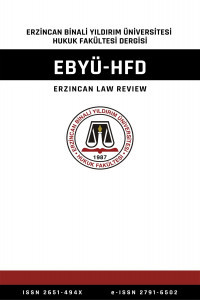DlŞ TİCARET BEŞERİ SERMAYE VE İKTİSADİ GELİŞME ARASINDAKİ UZUN DÖNEM NEDENSELLİK İLİŞKİSİNİN TESTİ
Dış Ticaret, Beşeri Sermaye, Büyüneye Etki Eden Faktörler
A TEST OF LONG-RUN CAUSALITY RELATION AMONG FOREIGN TRADE HUMAN CAPITAL AND ECONOMIC GROWTH
___
- Ahmad, J., (2001), “Causality Between Exports and Economic Growth: What do the Econometric Studies Teli Us”, Pacific Economic Review, 6, ss. 147-167.
- Al-Yousif, Y., K., (1997), “Exports and Economic Growth: Some Empirical Evidence from the Arab Gulf Countries”, Applied Economics, 29, ss. 693- 697.
- Bahmani-Oskooee, M. ve Domaç, İ., (1995), “Export Growth and Economic Growth in Turkey: Evidence from Cointegration Analysis”, METU Studies in Development, 22, ss. 67-77.
- Balaguer, J. ve Cantavella-Jorda, M., (2004), “Structural Change in Exports and Economic Growth: Cointegration and Causality Analysis for Spain (1961-2000)”, Applied Economics, 36, ss. 473-477.
- Bumey, N, A., (1996), “Exports and Economic Growth: Evidence from Cross-Country Analysis”, Applied Economics Letters, 3, ss. 369-373.
- Darrat, A. F., Hsu, M: K. ve Zhong, M., (2002), “Foreign Trade, Human Capital and Economic Growth in Taiwan: A Reexamination”, Studies in Economics and Finance, 20 (3), ss.85-94.
- Davvson, P. J. ve Hubbard, L. J., (2004), “Exports and Economic Growth in Central and East European Countries During Transition”, Applied Economics, 36, ss. 1819-1824.
- Dritsakis, N., (2004), “Export, Invesments and Economic Development of Pre-accession Countries of the European Union: An Empirical Investi- gation of Bulgaria and Romania”, Applied Economics, 36, ss. 1831- 1838.
- Dutt, S. ve Ghosh, D., (1994), “An Empirical Investigation of the Export Growth-Economic Growth Relationship”, Applied Economics Letters, 1, ss. 44-48
- Ghosh, S., (2002), “Electricity Consumption an Economic Growth in India”, Energy Policy, 30, ss. 125-129.
- Griliches, Z., (1997), “Education, Human Capital, and Growth: A Personal Perspective”, Journal of Labor Economics, 15, ss. 330-344.
- İslam, M. N., (1998), “Export Expansion and Economic Growth: Testing for Cointegration and Causality”, Applied Economics, 30, ss. 415- 425.
- Jin J. C. ve Yu, E. S. H., (1996), “Export-led Growth and the US Economy: Another Look”, Applied Economics Letters, 3, ss. 341-344.
- Keong, C. C., Yusop, Z,, ve Liew, V. K., (2003), “Export-led Growth Hy- pothesis in Malaysia: An Application of Two- Stage Least Square Tech- nique”, http://ideas.repec.Org/p/wpa/wuwpif70308002.html
- Khalafalla, K. Y. ve Webb, A. J., (2001), “Export-led Growth and Structural Change: Evidence from Mataysia”, Applied Economics,, 33, ss. 1703- 1715.
- Kibritçioğlu, A., (1998), “İktisadi Büyümenin Belirleyicileri ve Yeni Büyüme Modellerinde Beşeri Sermayenin Yeri”, A.Ü. SBF Dergisi, 53, ss. 207-230.
- McCarville, M. ve Nnadozie, E., (1995), “Causality Tests of Export-led Growth: The Case of Mexico”, Atlantic Economic Journal, 23, ss. 140- 145-
- Onafowora, O. A. ve Owoye, O., (1998), “Can Trade Liberalization Stimu- late Economic Growth in Africa?”, WoId Development, 26, ss. 497-506.
- Özmen, E. ve Furtun, G., (1998), “Export-led Growth Hypothesis and The Turkish Data: An Empirical Investigation”, METU Studies in Development, 25, ss. 491-503.
- Parasız, î., (1998), Türkiye Ekonomisi: 1923’ten Günümüze İktisat ve İstikrar Politikaları, Ezgi Kitabevi, Bursa.
- Shan, J. ve Sun, F., (1998a), “On the Export-led Growth Hypothesis: The Econometric Evidence from China”, Applied Economics, 30, ss. 1055- 1065.
- Shan, J. ve Sun, F., (1998b), “Export-led Growth Hypothesis for Australia: An Empirical Re- investigation”, Applied Economics Letters, 5, ss. 423-428.
- Shan, J. ve Sun, F., (1999), “ Export-led Growth and the US Economy:
- Some Further Testing”, Applied Economics Letters, 6, ss. 169-172
- Shan, J. ve Tian, G. G.j (1998), “Causality Between Export and Economic Growth: The Empirical Evidence from Shanghai”, Australian Economic Papers, 37, ss. 195-202.
- Thomton, J., (1996), “Cointegration, Causality and Export-led Growth in Mexico, 1895-1992”, Economics Letters, 50, ss. 413-416.
- ISSN: 2651-494X
- Yayın Aralığı: 1
- Başlangıç: 2002
- Yayıncı: Erzincan Üniversitesi Hukuk Fakültesi Dekanlığı
ALMAN VE TÜRK ÖZEL SİGORTA HUKUKUNDA SİGORTA ETTİRENİN KURTARMA ÖDEVİ
İNSAN HAKLARININ ANAYASAL KONUMU
TÜRKİYE’DE ARAÇ TALEBİ VE YAKİT FIYATLARİ ARASINDAKİ İLİŞKİNİN EŞBÜTÜNLEŞME TEKNİĞİ İLE İNCELENMESİ
KAMU GÖREVLİLERİNİN NAKLEN ATANMA KRİTERLERİ
GELİR DAĞILIMINDA DEĞİŞMELER VE ERZURUM ÖRNEĞİ
Alaattin KIZILTAN, Fatmanur ÇUBUKÇU
BİLİM ÖZGÜRLÜĞÜ: İÇERİĞİ VE SINIRLANDIRILMASI Sorunu
PLATON’UN DEVLETİN KÖKENİNE İLİŞKİN GÖRÜŞÜ VE YANSIMALARI
İKTİSADİ MÜESSESELERDE TÜRKÇE KULLANMA ZORUNLULUĞU
551 SAYILI PATENT HAKLARININ KORUNMASI HAKKINDA KANUN HÜKMÜNDE KARARNAMEDE YAPILAN DEĞIŞIKLIKLER
İCRA VE İFLÂS HUKUKUMUZDA HACZEDİLMEZLİKTEN FERAGAT (İİK. m. 83/a)
